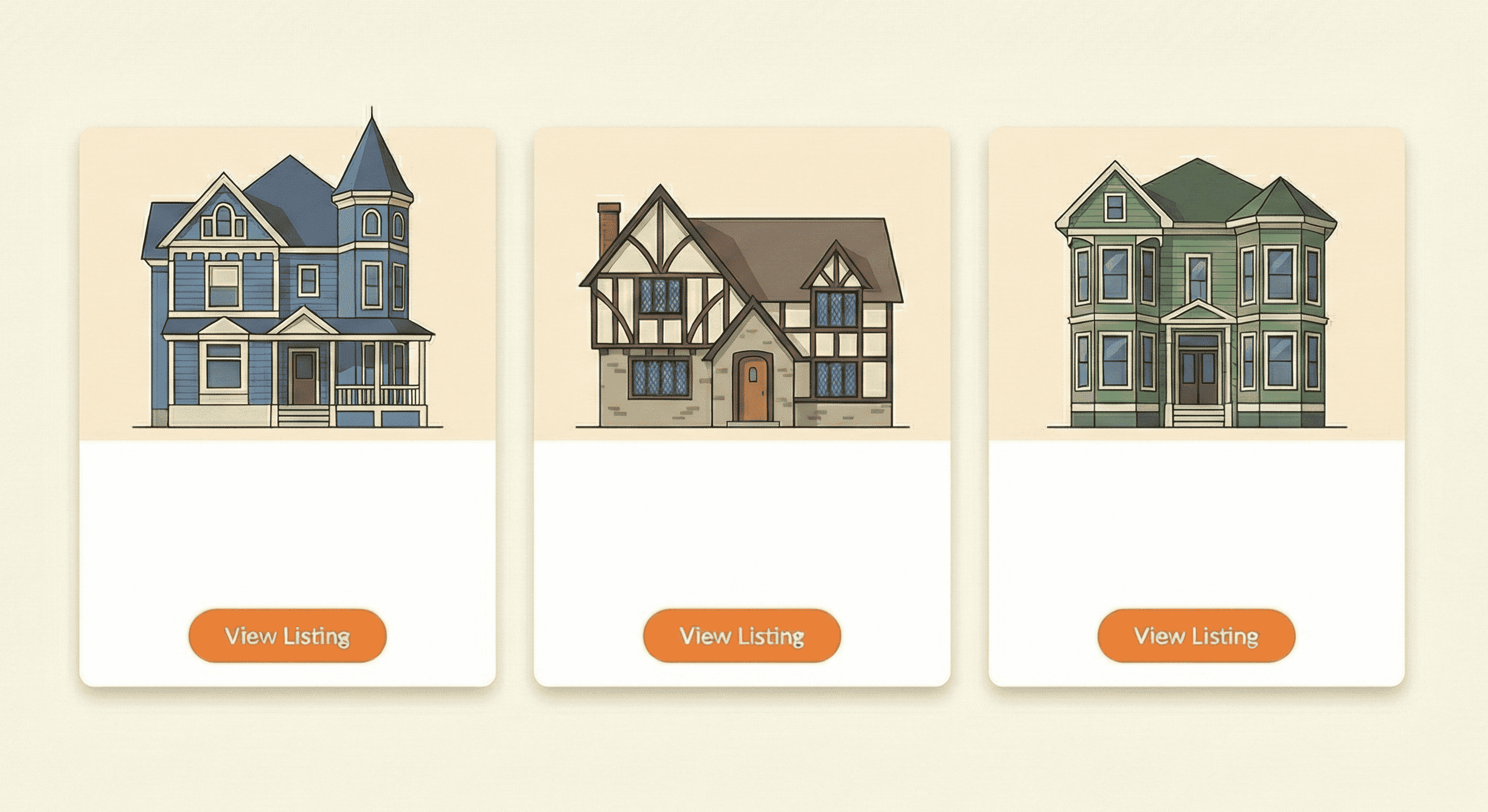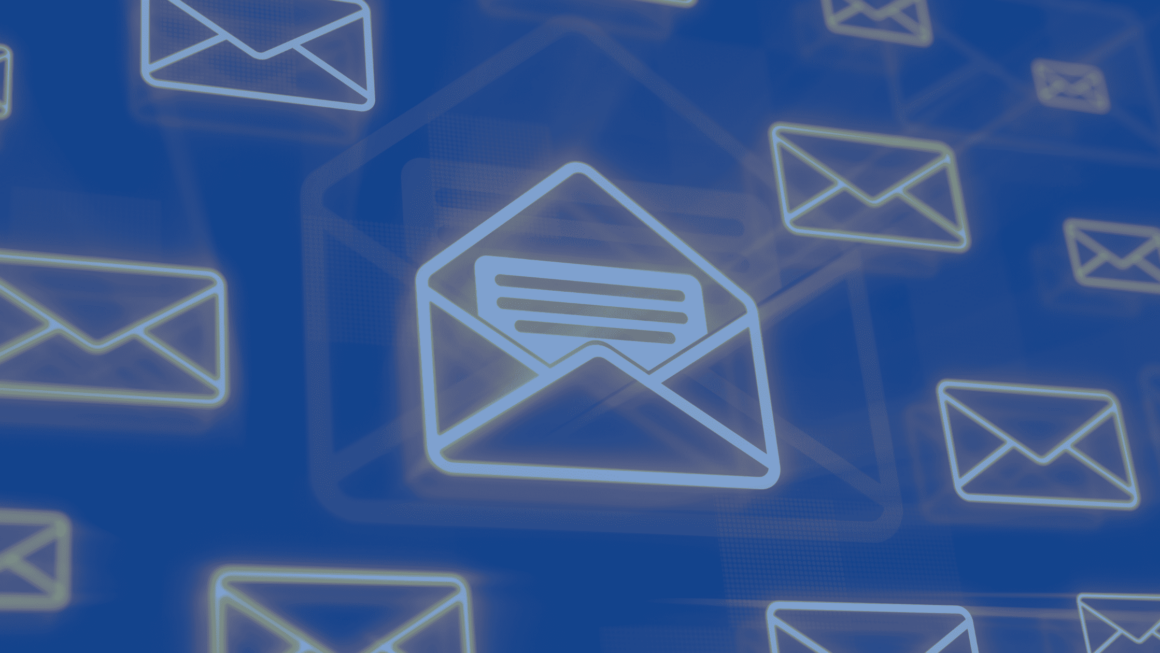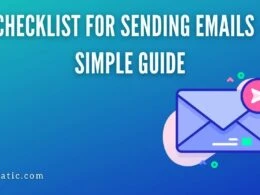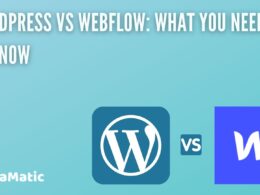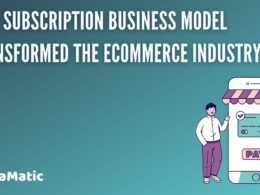Introduction to Email Automation
Email marketing is a powerful way for businesses to connect with customers. It can build relationships and drive sales. But it can also be time-consuming. This is where email automation can help. It can save time and make email marketing more effective.
Email automation uses software to automate email marketing tasks. It works by sending emails based on triggers. Triggers are pre-defined actions your customers take.
Examples include signing up for a newsletter or buying a product. Automated emails are sent when a customer’s behaviour matches the conditions in a workflow. This means the right emails reach the right people at the right time.
Why is email automation important?
Email automation has many benefits. It can help businesses:
- Improve customer engagement: Stay in touch with customers and keep them interested in the brand. Send targeted messages relevant to their interests.
- Increase sales: Generate leads and drive sales by sending automated emails that promote products or services.
- Save time and effort: Automate email marketing tasks and focus on other parts of the business.
How can email automation enhance engagement and sales?
There are many ways email automation can boost engagement and sales. Here are some common examples:
- Welcome emails
- Abandoned cart emails
- Post-purchase emails
- Re-engagement emails
Email automation can be a powerful tool for businesses of all sizes. By automating emails, businesses can save time, improve customer relationships, and increase sales.
Key Features to Look for in Email Automation Software
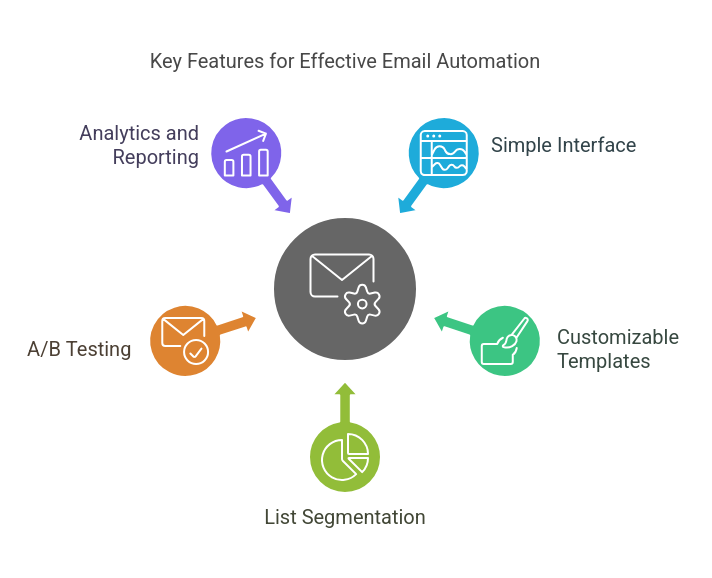
Finding the right email automation software can be overwhelming. There are many options available. It’s important to choose a platform with the features you need.
Here are some key features to look for:
- Simple interface: A simple interface is crucial. The software should be easy to navigate. You should be able to create and send emails without any hassle.
- Customizable templates: Look for software that offers customizable email templates. Customizable templates can save you time. They can help you create professional-looking emails. You can also brand your emails to match your company’s style.
- List segmentation and targeting: Segmentation allows you to divide your email list into smaller groups. You can send targeted emails to specific segments. Targeting helps ensure that your emails are relevant to the people who receive them. This leads to higher engagement and conversion rates.
- A/B testing capabilities: A/B testing lets you test different versions of your emails. You can see which version performs best. This helps you optimize your email campaigns for better results.
- Analytics and reporting features: Robust analytics and reporting features help you track the success of your email campaigns. You can see metrics like open rates, click-through rates, and conversion rates. This data can help you improve your future campaigns.
These are just a few of the key features to look for in email automation software. Make sure to choose a platform that meets your specific needs and budget.
Top Email Automation Software Options
Here is an overview of some leading email automation tools, comparing their features, pricing, user ratings, pros, and cons:
1. Brevo
Brevo is an all-in-one marketing and sales platform that offers powerful automation features at an affordable price. It even has a free plan that allows you to send up to 300 emails a day.
Features:
- Pre-built automation workflows based on goals such as improving engagement, increasing traffic, growing revenue, or building relationships
- Dozens of pre-made email templates and a drag-and-drop editor
- AI Assistant for generating email content
- CRM with 100,000 contacts, segmentation into focused lists, and the option to buy prepaid credits to exceed the daily email limit
- Transactional email function for sale confirmations and invoices
- SMS marketing
Pricing:
- Free for up to 300 emails per day and 100,000 contacts
- Paid plans start at $29/month for 20,000 subscribers
Pros:
- Affordable pricing
- Free CRM with lead scoring
- Includes transactional emails and SMS marketing
- Generous free plan
Cons:
- Limited automation templates
- Extra user accounts cost extra ($12/month per user)
- No tagging functionality
- Strict 300 email/day send limit
2. MailerLite
MailerLite is an email marketing provider that stands out for its simple interface and affordable pricing.
Features:
- Dynamic, pre-designed content blocks for building email campaigns and custom templates
- Countdown timer feature for emails
- Robust automation and audience segmentation features in the free plan
- Intuitive automation workflow builder with pre-built flows
- Landing page editor
- Easy-to-edit forms
Pricing:
- Free for up to 1,000 subscribers and 12,000 emails per month
- Paid plans start at $10/month for 1,000 subscribers
- $39/month for 5,000 subscribers
Pros:
- Simple design
- Affordable pricing
- Generous free plan
- Good deliverability
Cons:
- Limited subscriber management tools
- Lacks automation for more advanced triggers like website visits
- No pre-made email templates on the free plan
3. Mailchimp
Mailchimp is a popular email marketing service that offers a wide variety of features. Yet, automation is no longer available on its free plan.
Features:
- Landing page builder
- Customer journey mapping
- List segmentation
- Retargeting ads
- A/B testing
- Approachable editor with helpful tips and best practices
- Scalable pricing with three different paid tiers
- Automation such as standard autoresponders, blog update triggers, and e-commerce integrations
Pricing:
- Free for up to 500 contacts and 1,000 sends per month (500 per day)
- Essential plan starts at $13/month
- Premium plan (with advanced segmentation, A/B testing, and reporting) starts at $350/month
Pros:
- Wide range of features
- Integrates with hundreds of apps, including e-commerce, CRM, social and blogging platforms
- Scalable pricing
Cons:
- No automation on the free plan
- Relatively expensive
- Charges for inactive contacts
- Limited free plan
4. ActiveCampaign
ActiveCampaign is a powerful email automation tool that’s best for more advanced users. It provides enterprise-grade automation at a price that’s accessible to small and medium businesses.
Features:
- Segmentation, dynamic content, site tracking, lead scoring
- Built-in CRM
- Thousands of pre-built automation templates
Pricing:
- Starts at $15/month for 500 contacts
- Plus plan (with most cross-channel marketing features) starts at $70/month
- $179/month for 5,000 contacts on the Plus plan
Pros:
- Powerful automation features
- Good deliverability
- CRM add-on for integrated sales and marketing automation
Cons:
- Can be daunting and takes time to learn
- AI automation builder doesn’t run smoothly
- The entry-level plan has limited automation features
- Expensive
5. GetResponse
GetResponse is a well-rounded email marketing platform. It offers tools for building landing pages, hosting webinars, and creating an AI-powered website. GetResponse has a free plan for up to 500 contacts. Paid plans start at $19 per month.
Features:
- Advanced automation workflows
- Webinar hosting tool
- AI-powered website generator
- Live chat
- Email marketing
- Event-based automation
- Landing page builder
- Signup forms
- Pop-ups
Pros:
- Complete set of marketing and sales features
- Offers around 40 automation templates
- Excellent landing page features and conversion funnels
- Generous free plan
Cons:
- Email automation is only on higher-tier plans
6. Constant Contact
Constant Contact is a good option for event marketing and social media management. It does not have a free plan. Plans start at $9.99 per month for 500 subscribers.
Features:
- Event marketing tools
- Social media management
- List management
- Workflow automation
- Embeddable website forms
- Simplified reporting
Pros:
- Simple to use
- Good for a non-technical audience
- Includes all the standard features you’d expect in email automation software
Cons:
- Outdated user interface
- More expensive than other tools with similar features
7. Drip
Drip specializes in email marketing for e-commerce. Its pricing is $39 per month for 2,500 contacts. Drip integrates with popular e-commerce platforms like Shopify, Magento, WooCommerce, and BigCommerce.
Features:
- E-commerce integrations
- Workflow templates for e-commerce, including abandoned cart, post-purchase, win-back, birthday, and welcome emails
- Personalized product recommendations
- Customer segmentation synced with Facebook Custom Audience insights
Pros:
- Straightforward pricing
- Easy-to-use and intuitive workflow editor
- Excellent for e-commerce automation and segmentation
- Flexible automation editor suitable for non-e-commerce businesses
Cons:
- Email editor isn’t very flexible
- Form editor requires coding knowledge to insert dropdown or checkbox fields
- Geared toward established businesses
- No warning is shown if you exceed the subscriber limit; Drip will naturally upgrade your plan
8. Omnisend
Omnisend is another e-commerce email marketing tool. It has a free plan for up to 250 contacts and 500 emails per month. Paid plans start at $16 per month.
Features:
- Dynamic customer lifecycle features
- Ad retargeting
- Customer data management
- Email gift boxes
- Scratch cards
- Integration with Google and Facebook ads
- E-commerce-specific automation features like cart recovery, order confirmations, cross-selling, customer reactivation, and browse abandonment
Pros:
- Easy-to-use automation editor with pre-made templates
- Plenty of good e-commerce-specific templates
- Conditional splitting for more advanced automation
- Omnichannel marketing and automation across email, SMS, and social media
Cons:
- Limited range of automation templates
- Fewer AI features than competitors
9. HubSpot
HubSpot is a popular customer relationship management (CRM) platform. It offers email automation tools as part of a broader set of marketing and sales features.
Features:
- Contact management
- Email tracking
- Lead scoring
- Dynamic list building
- Segmentation
- Lead routing
- Internal notifications
- Task automation
- Lead notifications
- Email marketing campaigns
Pricing:
- Free plan for basic contact management
- Basic plan starts at $50 per month
- The professional plan (with most automation features) costs $890 per month
Pros:
- Comprehensive platform
- Generous free plan
Cons:
- Expensive, especially for the Professional plan, which requires to access most of the automation features
- High onboarding fees
- Historically poor deliverability
10. EmailOctopus
EmailOctopus focuses on simple email marketing services for developers. It is very affordable because it routes emails through Amazon Simple Email Service (SES). It has a free plan for up to 2,500 subscribers. Paid plans begin at $7 per month.
Features:
- Email routing through Amazon SES
- Subscriber list management
- Automation of transactional and promotional emails
Pros:
- Quite cheaper than most other providers
- Generous free plan
- Ultra-affordable upgrades
- Access to most features on the free plan
Cons:
- Clunky editor
- Basic automation features
11. Sender
Sender is famous for its generous free plan. This includes 2,500 subscribers and 15,000 emails per month. You also have full access to automation and segmentation. Paid plans start at $47.50 per month for 10,000 subscribers.
Features:
- Automation
- Audience segmentation
- Over 60 email templates
- Pre-built automation workflows for welcome series, thank you series and abandoned cart campaigns
Pros:
- Generous free plan with lots of features
- Affordable upgrade costs
Cons:
- Clunky drag-and-drop editor
12. Klaviyo
Klaviyo is a popular email marketing automation platform for e-commerce. It has a free plan that allows you to send up to 500 emails per month to 250 contacts. Paid plans start at $20 per month for 500 contacts.
Features:
- Email and SMS automation for e-commerce
- Deep integration with e-commerce systems
- Over 70 automation templates
- AI-driven tools
- Intuitive form builder
- Dynamic product feeds
- Personalized content options
Pros:
- Lots of features particularly for online stores
- Good for e-commerce companies using Shopify or other platforms
Cons:
- Can be difficult to learn
- Expensive for large subscriber lists
Setting Up Your Email Automation Strategy
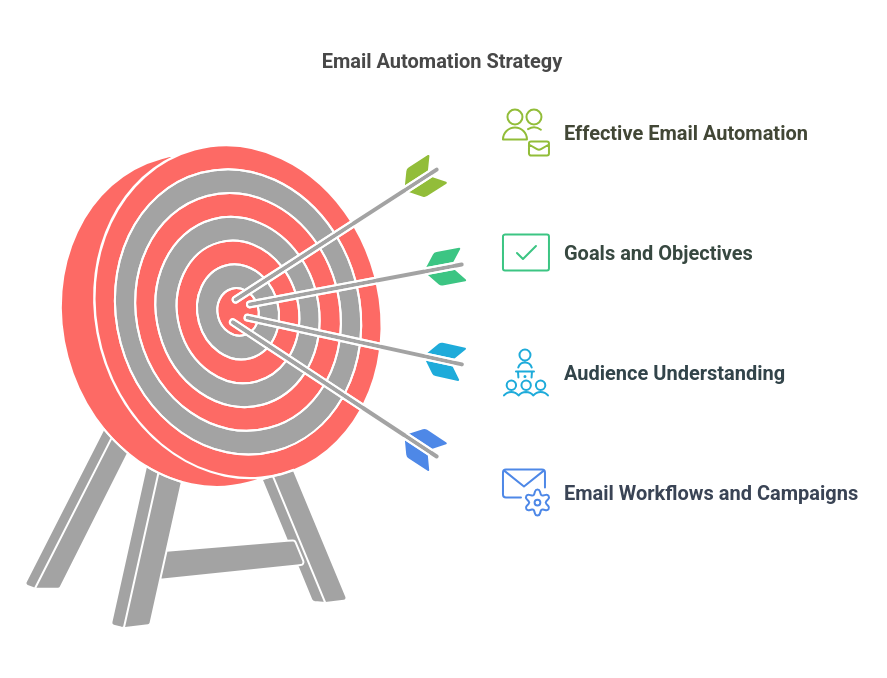
Setting up an effective email automation strategy involves defining your goals, understanding your audience, and creating compelling email workflows and campaigns. Here’s a breakdown:
Defining Your Goals and Objectives
Before diving into automation, you need clear goals. Ask yourself what you want to achieve with email automation. Some common goals include:
- Boosting brand awareness
- Generating leads
- Nurturing leads
- Driving sales
- Improving customer retention
- Increasing customer engagement
Your goals will shape your automation strategy and the types of campaigns you create.
Understanding Your Audience for Targeted Campaigns
Email automation is most effective when you send the right message to the right people at the right time. Segmentation is key. This involves dividing your audience into smaller groups based on shared characteristics.
Here are some ways to segment your audience:
- Demographics: Age, gender, location
- Behaviour: Purchase history, website activity, email engagement
- Interests: Products or content they’ve shown interest in
- Lifecycle stage: Lead, prospect, customer, loyal customer
Once you’ve segmented your audience, you can tailor your email content and messaging to resonate with each group. Personalization can vastly improve the effectiveness of your email campaigns.
Creating Effective Email Workflows and Campaigns
Workflows are automated sequences of emails triggered by specific actions or events. Here are some examples:
- Welcome series: A series of emails sent to new subscribers. These emails introduce your brand, highlight key products or services, and encourage engagement.
- Abandoned cart emails: Sent to shoppers who add items to their cart but don’t complete the purchase. These emails remind them of the items they left behind and often offer incentives to encourage them to return.
- Post-purchase follow-ups: Sent after a customer makes a purchase. These emails can thank the customer, provide order information, suggest related products, and gather feedback.
- Re-engagement campaigns: Targeted inactive subscribers who haven’t engaged with your emails in a while. These emails try to rekindle interest by offering exclusive content, discounts, or updates.
When building workflows, consider the following:
- Triggers: What actions or events will initiate the workflow?
- Timing: When will each email in the sequence be sent?
- Content: What message will each email convey?
- Call to action: What action do you want recipients to take?
Measuring the Success of Your Email Automation Efforts
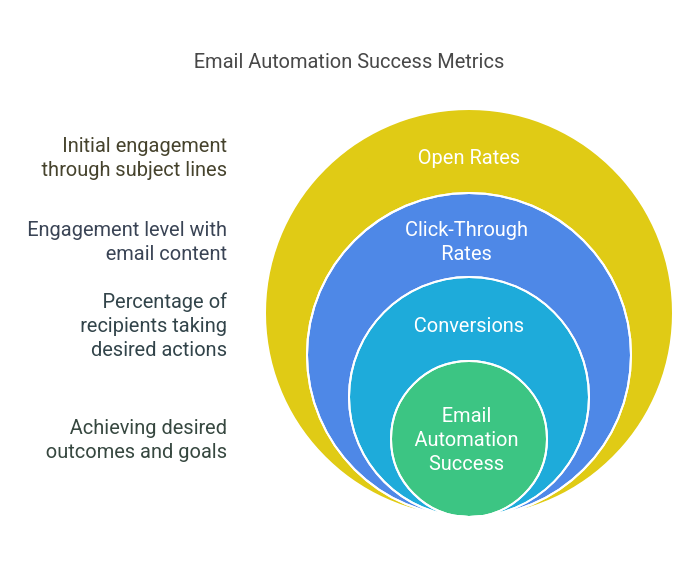
You need to track key metrics to measure the success of your email automation efforts. This will allow you to make data-driven decisions and always improve your campaigns. Here’s a breakdown of important metrics and how to analyze data:
Key Metrics to Check Engagement
These metrics provide insights into how your audience interacts with your emails:
- Open Rates: This measures the percentage of recipients who open your emails. A higher open rate suggests your subject lines are effective at grabbing attention.
- Click-Through Rates (CTR): This shows the percentage of recipients who click on links in your email. A good CTR indicates that your email content is engaging and your calls to action are compelling.
- Conversions: This is the ultimate goal of many email campaigns. It tracks the percentage of recipients who take a desired action, like making a sale, signing up for a webinar, or downloading a resource.
Analyzing Data for Continuous Improvement
Look for patterns and trends in your data to identify what’s working and what needs improvement.
Consider the following questions:
- Which email campaigns have the highest open and click-through rates?
- What types of content resonate most with your audience?
- What calls to action are most effective at driving conversions?
Use this information to refine your email subject lines, content, design, and calls to action.
A/B testing is a valuable technique for optimizing your campaigns. Test different variations of your emails (e.g., subject lines, calls to action, layouts) to see what performs best.
Don’t forget to analyze the data from your automated workflows.
- Are your welcome series engaging new subscribers?
- Are your abandoned cart emails recovering lost sales?
- Are your post-purchase follow-ups generating repeat business and positive feedback?
By always analyzing and improving your email automation efforts, you can achieve better results and build stronger relationships with your audience.
Conclusion
Email automation is a great way to improve your email marketing. It can save you time and help you send better emails. There are many tools to help you automate emails. Some popular ones are ActiveCampaign, GetResponse, Brevo, Omnisend, and MailerLite.
You need to choose the right tool for your needs. Think about your goals and your budget. Then you can start automating your emails!
Here are some things to remember when setting up your email automation:
- Set clear goals. What do you want to achieve with email automation? For example, do you want to get more leads or increase sales? Once you know your goals, you can create email campaigns that help you achieve them.
- Understand your audience. You need to know who you’re sending them to to send effective emails. Divide your audience into smaller groups based on their age, location, interests, and sales history. This is segmentation. It lets you send more relevant emails.
- Create good email workflows. A workflow is a series of emails that are sent automatically. For example, you can set up a workflow to send welcome emails to new subscribers. Workflows can help you nurture leads and build relationships with your customers.
- Track your results. It’s important to track how your email automation is performing. Look at metrics like open rates, click-through rates, and conversions. This information will help you improve your campaigns over time.
Email automation can help you get better results from your email marketing. By automating tasks and sending targeted emails, you can save time and improve your relationships with your customers.
READ MORE:


